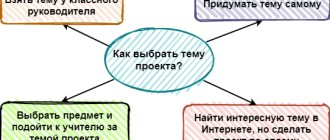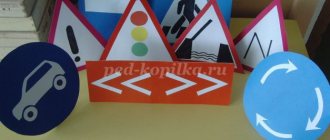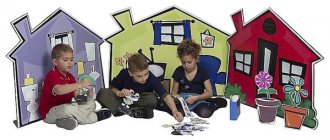Table of the main stages of GCD methodological development (senior group)
Main stages of GCD
| Blocks | Stage number | Stage name | Tasks | Contents of the stage | Planned result |
| prepare telny | 1 | Organizational |
| Children are asked to find familiar LEGO elements in a box of parts and name them. | Attracting the attention of children, getting them into the mood for work. |
| basic | 1 | Preparatory (preparation for mastering new content) | — ensuring motivation and acceptance by children of the goals of educational and cognitive activity | Children are divided into 2 teams and complete the teacher’s task - they assemble a tower from LEGO parts. | Set up children to work in a team, consolidate their knowledge of familiar LEGO elements. |
| 2 | Basic:
|
| The teacher shows the children how to fasten LEGO pieces together and offers to do graphic exercises with them. | Continue to familiarize children with the shape of LEGO parts - molds and bricks and options for fastening them together. | |
| 3 |
generalization and systematization of knowledge |
— formation of a holistic idea of the object of study | Children are invited to make a building from LEGO parts from memory or using a diagram on their own. | Develop the ability to listen to the teacher’s instructions, work independently with the elements of the construction set, and fasten parts in different ways. | |
| 4 | Control | — identifying the quality and level of mastery of knowledge and skills and their correction | The teacher invites the children to make various buildings for the inhabitants of the LEGO country. | To identify the level of children’s assimilation of previously acquired knowledge about the LEGO constructor. | |
| final | 1 | Final | - provide an analysis and assessment of the success of achieving the goal | Examine the resulting buildings with the children. | Watch how the children do the work, listen to the instructions, how they correctly fasten the parts, and note the effectiveness of the work. |
| 2 | reflective | — mobilization of children for self-esteem | Invite children to play with LEGO buildings. | Encourage children to play independently using LEGO constructors. |
Lesson 7 “Researchers of molds and bricks”
Target. Continue introducing children to the LEGO constructor, the shape of LEGO parts - molds and bricks, and options for fastening them. Continue compiling the LEGO dictionary. Develop the skill of distinguishing parts in a box and classifying parts. Practice the ability to listen to the teacher’s instructions and give instructions to each other.
Equipment. A LEGO set, albums and markers, two pinwheels (one with color, the other with shapes of LEGO parts).
Progress of the lesson 1. Organizing moment
LEGO friend. Guys, we have explored both LEGO bricks and molds. You and I already know a lot of interesting stories about them and know how to play with them. But today we have to show what we have learned and continue our research.
A LEGO friend invites children to find a LEGO piece in a “magic box” and guess what it is called.
2. Development of orientation in details Game “Find the same part” This is carried out similarly to point 2 of lesson 6, only in front of the children are all the LEGO parts.
3. Classification The teacher forms 2 teams of researchers: boys and girls.
1st option
Teacher. A LEGO friend wants to know whose team is the most attentive. True researchers must have many qualities, and attentiveness is one of the most important. Attention: girls must build a tower from bricks, and boys from molds.
At the end, the towers are compared in terms of height and stability. It should be noted that both towers are very beautiful, but the boys’ tower is cheerful, and the girls’ tower is serious (strict).
2nd option
LEGO friend. My wonderful researchers, you now need to complete an even more difficult task: the boys build 4 towers using 2x2, 2x4, 2x6 bricks. Girls - from every type of mold.
4. Working on options for fastening molds and bricks, developing imagination Game “Dreamers”
A LEGO friend invites children to play and get creative.
1st option
It is necessary to determine who is the best dreamer. To do this, everyone needs to take 2 parts - a mold and a brick and try different options for fastening them. At the end, the children compare what they did.
2nd option
LEGO friend shows 3 different LEGO pieces. Children must come up with as many fastening options as possible. Then the children discuss what they did.
5. Graphic exercises LEGO friend invites researchers to sketch the most interesting options for fastened LEGO elements. Children make drawings.
6. Following verbal instructions Game “Listen and Do”
It is carried out by analogy with the game in lesson 5, the teacher (LEGO friend) begins to set the task, and the child continues. But here both molds and bricks (no more than 5 parts) are used in buildings.
7. Memory development task LEGO friend. Yesterday I discovered a very interesting building and I want to show it to you. Let's look at it together, and then I'll see who can make exactly the same one from memory.
The building is made from 3-4 parts of different shapes and colors, fastened in different ways.
8. Free constructive play activities and development of children’s speech LEGO-friend invites children to make various interesting buildings, toys, etc. for the residents of LEGO country.
Children are surveyed on the diagrams before starting construction and at the end of the task.
Children's answers. Children build to music.
9. Summary LEGO friend. Guys, you have created such beautiful buildings that only color photography can convey their beauty and brightness! We'll take a picture of them now. Now play with them, but first let's tell a LEGO friend about how you can play with them in LEGO Magic Land.





